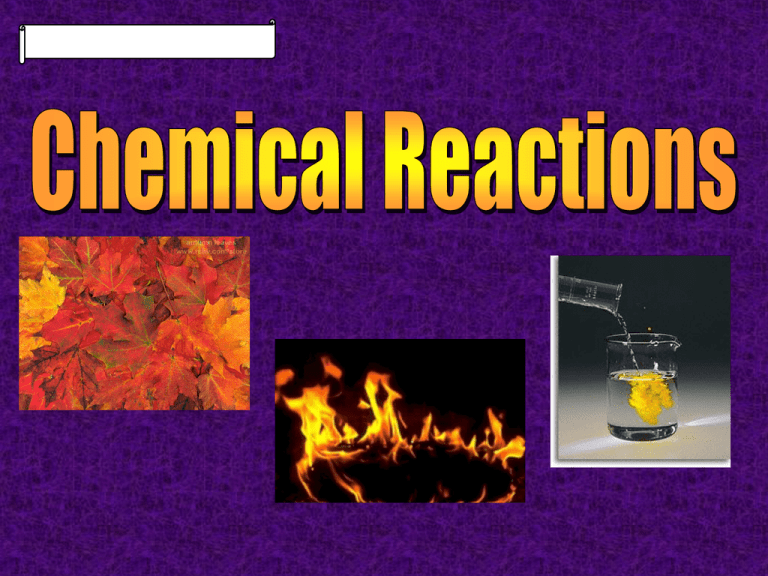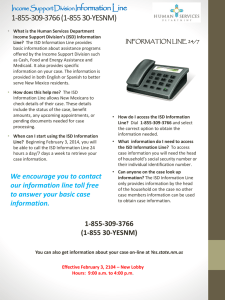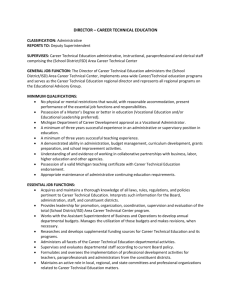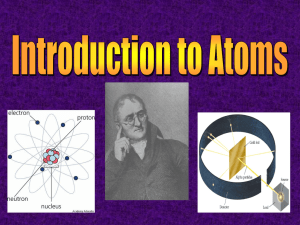Chemical Reaction
advertisement

What is a Chemical Reaction? What Do You Think? What do baking bread, riding in a car, and digesting food all have in common? © Fall 2005, Pflugerville ISD, 8th Grade Unit A : Chapter 1 : Section 1 What is a Chemical Reaction? Autumn Leaves © Fall 2005, Pflugerville ISD, 8th Grade •The change that occurs as chlorophyll decomposes into new compounds is a chemical reaction Unit A : Chapter 1 : Section 1 What is a Chemical Reaction? Autumn Leaves •A chemical reaction is the process by which one or more substances changes to produce one or more different substances © Fall 2005, Pflugerville ISD, 8th Grade Unit A : Chapter 1 : Section 1 Examples of Chemical Reactions Striking a match, baking bread, and using a battery are all examples of chemical reactions © Fall 2005, Pflugerville ISD, 8th Grade Unit A : Chapter 1 : Section 1 Clues to Chemical Reactions Heat, Gas Formation, and a Change in Color are clues that a chemical reaction is going on © Fall 2005, Pflugerville ISD, 8th Grade Unit A : Chapter 1 : Section 1 Reaction of Hydrogen and Chlorine In a Chemical Reaction, bonds are broken and new bonds are formed © Fall 2005, Pflugerville ISD, 8th Grade Unit A : Chapter 1 : Section 1 Why are Chemical Formulas and Equations Important? What Do You Think? What are some problems you might face if you were asked to translate information from your language to another? © Fall 2005, Pflugerville ISD, 8th Grade Unit A : Chapter 1 : Section 1 Chemical Formulas •All substances are formed from about 100 elements from the periodic table •Each element has its own chemical symbol © Fall 2005, Pflugerville ISD, 8th Grade Unit A : Chapter 1 : Section 1 Chemical Formulas •The chemical symbols are all 1 or 2 letters long, and always begin with a capital letter •H- hydrogen •He- helium •Li- Lithium © Fall 2005, Pflugerville ISD, 8th Grade Unit A : Chapter 1 : Section 1 Chemical Formulas A Chemical Formula is an easy way to write a compound’s name using chemical symbols and numbers to represent atoms © Fall 2005, Pflugerville ISD, 8th Grade Unit A : Chapter 1 : Section 1 Chemical Formulas A Chemical Formula shows how many of each kind of atom are present in a molecule of the compound © Fall 2005, Pflugerville ISD, 8th Grade Unit A : Chapter 1 : Section 1 Chemical Formulas Glucose Water © Fall 2005, Pflugerville ISD, 8th Grade Oxygen Unit A : Chapter 1 : Section 1 Chemical Equations •What does this sheet music say? •If you are a musician, no matter what country you are from, you can read this © Fall 2005, Pflugerville ISD, 8th Grade Unit A : Chapter 1 : Section 1 Chemical Equations Carbon and Oxygen react to form Carbon Dioxide •In the same way, chemists from around the world must communicate about Chemical Reactions clearly •A Chemical Equation uses chemical formulas, plus signs, and arrows to describe a Chemical Reaction © Fall 2005, Pflugerville ISD, 8th Grade Unit A : Chapter 1 : Section 1 Chemical Equations Carbon and Oxygen react to form Carbon Dioxide •The Reactants, carbon and oxygen, are the starting materials in this reaction •The Products, in this case carbon dioxide, are the substances formed from a reaction © Fall 2005, Pflugerville ISD, 8th Grade Unit A : Chapter 1 : Section 1 Chemical Equations Carbon and Oxygen react to form Carbon Dioxide © Fall 2005, Pflugerville ISD, 8th Grade Unit A : Chapter 1 : Section 1 Chemical Equations © Fall 2005, Pflugerville ISD, 8th Grade Unit A : Chapter 1 : Section 1 Balancing Chemical Equations •In a Chemical Reaction, every atom in the reactants becomes part of the products •In a Chemical Equation, the atoms on each side need to be counted and balanced © Fall 2005, Pflugerville ISD, 8th Grade Unit A : Chapter 1 : Section 1 Balancing Chemical Equations •The Law of Conservation of Mass states that mass cannot be created or destroyed in chemical reactions •A Chemical Equation must show the same number and kind of atom on both sides of the arrow © Fall 2005, Pflugerville ISD, 8th Grade Unit A : Chapter 1 : Section 1 Balancing a Chemical Equation © Fall 2005, Pflugerville ISD, 8th Grade Unit A : Chapter 1 : Section 1 Balancing a Chemical Equation © Fall 2005, Pflugerville ISD, 8th Grade Unit A : Chapter 1 : Section 1 Balancing a Chemical Equation © Fall 2005, Pflugerville ISD, 8th Grade Unit A : Chapter 1 : Section 1 Balancing a Chemical Equation Step 1 1. Count the Atoms Step 2 Step 3 2. Balance the Oxygen 3. Balance the Hydrogen © Fall 2005, Pflugerville ISD, 8th Grade Unit A : Chapter 1 : Section 1 What is Energy? What Do You Think? How is energy involved when you digest a cheeseburger? © Fall 2005, Pflugerville ISD, 8th Grade Unit A : Chapter 1 : Section 1 Energy and Reactions •Chemical Energy is part of all Chemical Reactions •Energy is absorbed to break bonds •When new bonds form, energy is given off © Fall 2005, Pflugerville ISD, 8th Grade Unit A : Chapter 1 : Section 1 Exothermic Reactions •If the chemical energy of the reactants is greater than that of the products, the reaction gives off energy •This reaction is called Exothermic, which means “energy goes out” © Fall 2005, Pflugerville ISD, 8th Grade Unit A : Chapter 1 : Section 1 Endothermic Reactions Photosynthesis •If the chemical energy of the reactants is less than that of the products, the reaction takes in energy •This reaction is called Endothermic, which means “energy goes in” © Fall 2005, Pflugerville ISD, 8th Grade Unit A : Chapter 1 : Section 1 Activation Energy •Activation Energy is the smallest amount of energy needed for chemicals to react •Electricity, light, heat, or any other form of energy can provide the Activation Energy for a reaction © Fall 2005, Pflugerville ISD, 8th Grade Unit A : Chapter 1 : Section 1 Let’s Review! -1What are some examples of chemical reactions? What are some clues that a chemical reaction has taken place? © Fall 2005, Pflugerville ISD, 8th Grade Unit A : Chapter 1 : Section 1 Let’s Review! -2Explain how a balanced chemical equation illustrates that mass is never lost or gained in a chemical reaction. © Fall 2005, Pflugerville ISD, 8th Grade Unit A : Chapter 1 : Section 1 Let’s Review! -3What is an Endothermic reaction? What is an Exothermic reaction? What is Activation Energy? © Fall 2005, Pflugerville ISD, 8th Grade Unit A : Chapter 1 : Section 1





